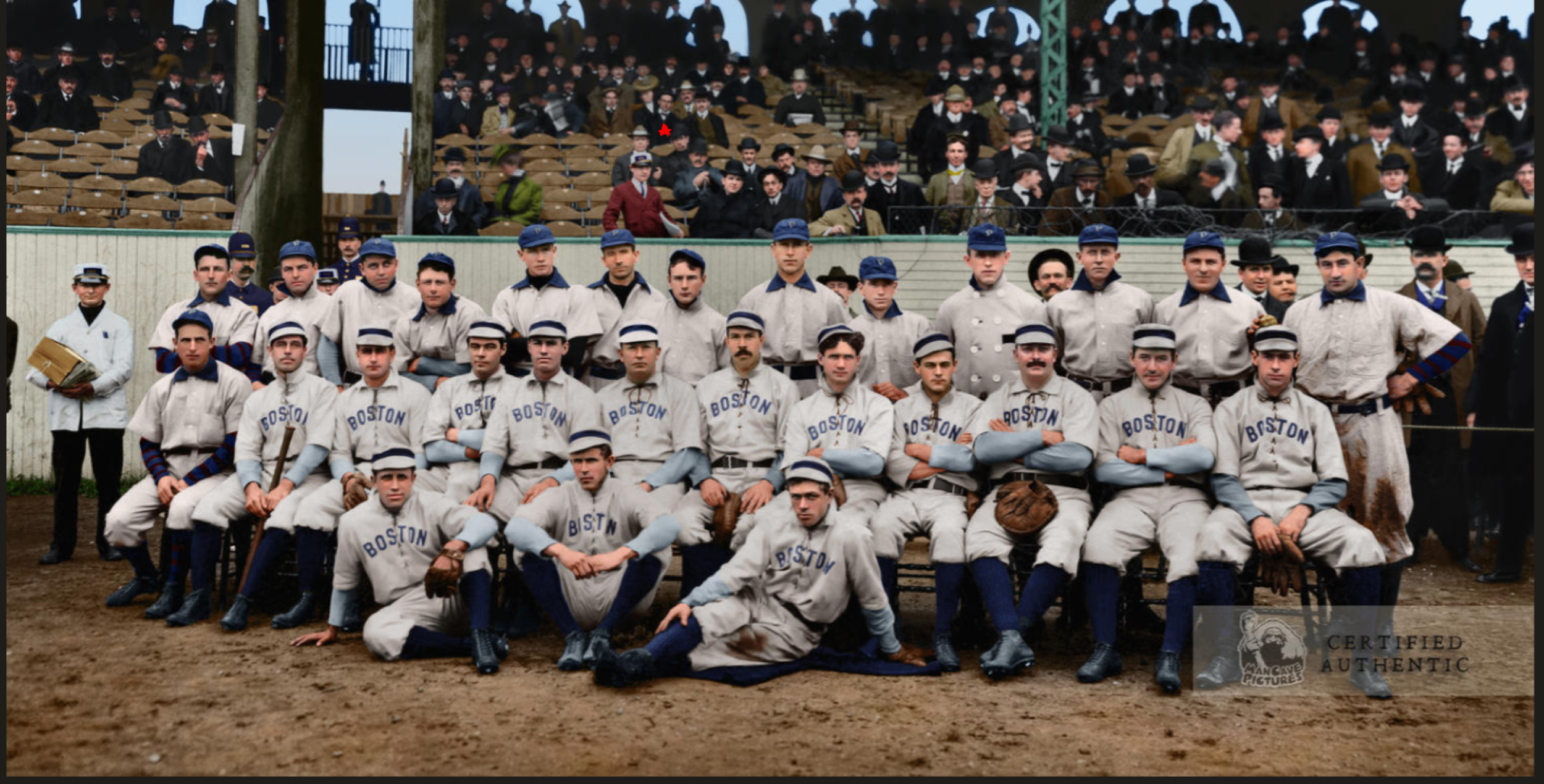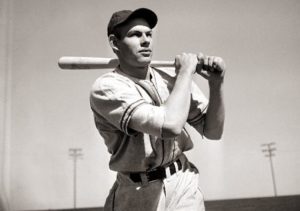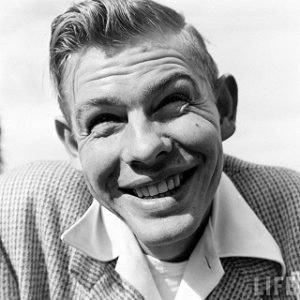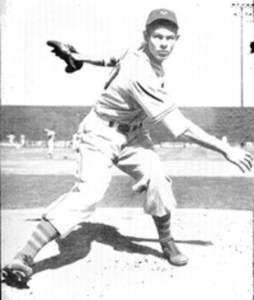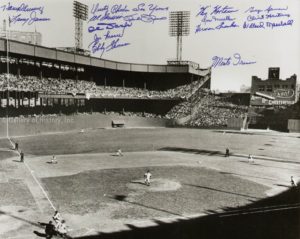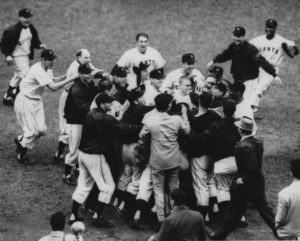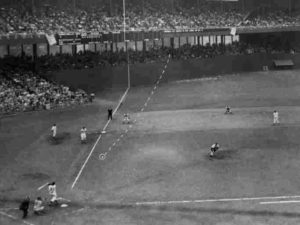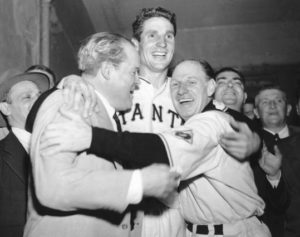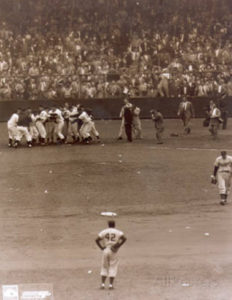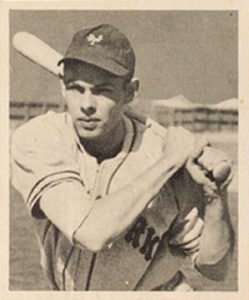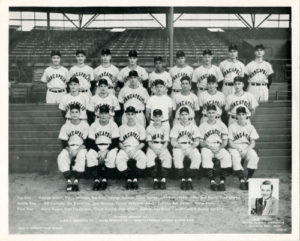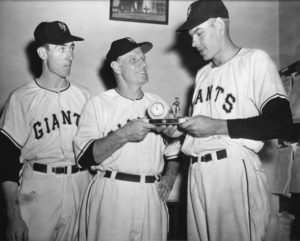Featured Photo Above:
Combined 1903 World Series Photo: Pittsburgh Pirates and Boston Pilgrims
(Color Restoration by Chris Whitehouse of Mancave Pictures)
Baseball History Comes Alive Now Ranked As a Top Five Website by Feedspot Among All Baseball History Websites and Blogs!
(Check out Feedspot's list of the Top 35 Baseball History websites and blogs)

Guest Submissions from Our Readers Always Welcome! Click for details
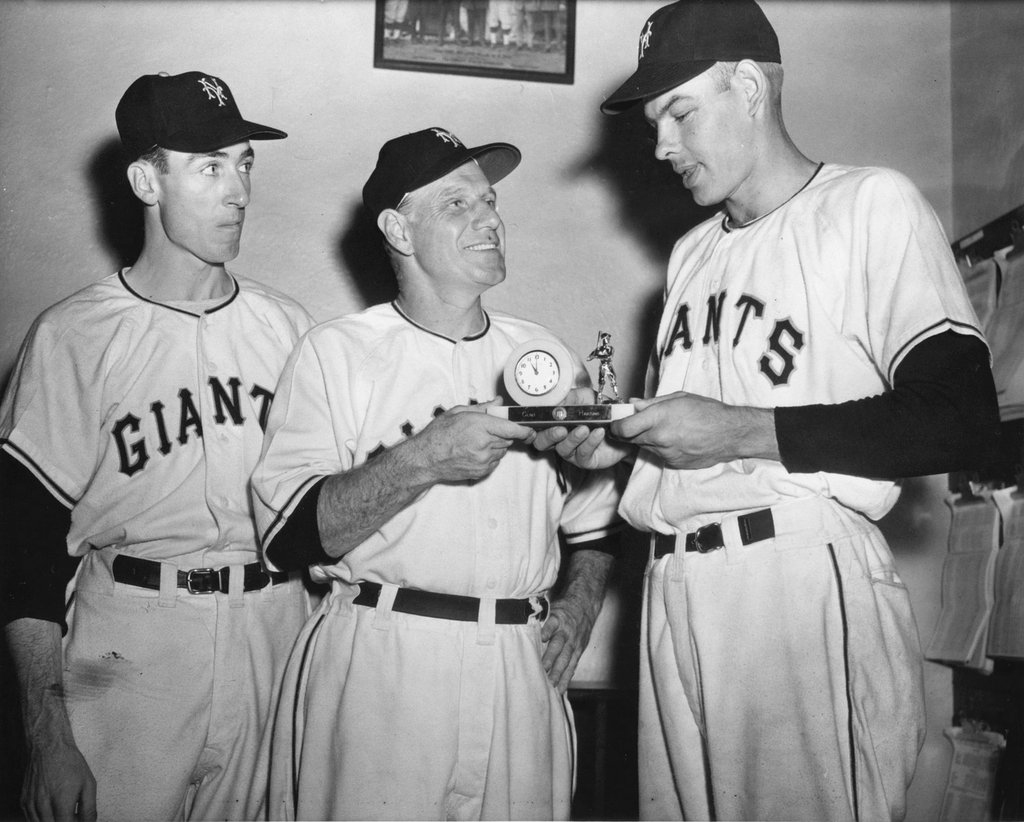
Subscribe to my blog for automatic updates and as a Bonus get instant access to my two Free Special Reports: “Memorable World Series Moments,” and “Gary’s Handy Dandy World Series Reference Guide!”
Clint Hartung Photo Gallery
Click on any image below to start Photo Gallery:
We Contacted By A Relative of Another Former Major Leaguer!
As we’ve mentioned many times, we always enjoy it when we’re contacted by relatives of former ball players. We’ve always found that even if the player isn’t real well known, there’s always something in his career that’s noteworthy, and today’s feature is no exception. To us, anyone who made it to the major leagues is “special,” and we’re always happy to say a few words about his career.
Recently we were contacted by Dylan Mills who is a relative of former New York Giant Clint Hartung. Maybe that name doesn’t immediately ring a bell, but I’ll bet you’re familiar with the game for which Clint is most remembered. Ever heard of “The Shot Heard Round the World”? I thought so. Now that I’ve got your attention, read on to find out more…
In the featured photo above, we see Clint Hartung with manager Leo Durocher.
Dylan Mill’s father was named Harry Hartung, and unfortunately, Harry passed away when Dylan and his twin brother Dustin were just six years old. Dylan never knew much about his father and over the years he lost contact with his father’s side of the family. One of the few things he knew about his dad was that he was an outstanding athlete who once had aspirations to play in the NFL. It’s a long story as to why Dylan’s last name isn’t “Hartung,” but he always wondered about his lost family relations on his father’s side.
Since Dylan grew up loving baseball, he also wondered if any ball players might possibly show up in his family line. One day, when Dylan was in his early twenties, while trying to “rediscover his family roots,” he did a Google search for the name “Hartung.” At the time, he didn’t know what he might find, but it turned out he was in for quite a shock!
When a photo of Clint Hartung popped up on Dylan’s computer screen, he knew right away that they had to be related. As he stared longingly at the photo, Dylan said “it was almost like looking in a mirror,” as the strong family resemblance was so obvious. Dylan immediately contacted his twin brother with the news; and they both had tears in their eyes as they gazed at the photo of the former major leaguer. An uncle later confirmed for them that Clint Hartung was indeed a relative, although what the exact relationship was, they’re still not sure.
Before I describe Clint Hartung’s role in one of the most famous moments in baseball history, let me tell you a little about his career. Although he didn’t play long (1947-52, all with the New York Giants), it certainly has its noteworthy moments.
The only word that describes the young Clint Hartung who caught the eye of the Giants during the mid-1940s is “phenom.” He eventually became one of the original “Bonus Babies,” signing with the Giants for the extraordinary sum of $35,000. Hartung was one of those rare athletes who exceled as both a pitcher and a hitter as a kid in high school and later in the minor leagues. During World War II, he played on several military teams, and on one such team, the Hickam Field Bombers, Hartung went 25-0, and hit .567!
The major league expectations for the strapping, Bunyanesque (6’ 4”, 200 pounds) Hondo, Texas native could not have been higher. By the time he was signed by the Giants, he had been touted in the New York press as the next Babe Ruth and Christy Mathewson rolled into one! It’s doubtful anyone could ever have lived up to such expectations. Talk about pressure! When he hit a home run in his first at-bat during an intrasquad game during spring training in 1947, the expectations went through the roof. Typical of his press clippings at the time was New York sportswriter and author Tom Meany’s comment: “Rather than stop at the Polo Grounds they should have taken him straight to Cooperstown!”
His career began well — he was 9-7 his rookie year and he also hit .306 — and many started to believe he was the “real deal.” But he was always a below-average fielder and his managers, Mel Ott and later Leo Durocher, didn’t know whether he was better suited as a pitcher or a position player. And so they tried to split the difference….to less-than-spectacular results. In 1948 his stats declined to 8-8 and .179. His pitching never recovered and by 1950, he was done on the mound. When he eventually made a permanent switch to the outfield, Hartung became only the 11th player in history whose first homer was as a pitcher and then later hit one as a position player. The previous player to do so was named Babe Ruth, and it didn’t happen again until pitcher-turned-outfielder Rick Ankiel did it in the 2000s.
His disappointing six-year major league career pitching record was 29-29, and his batting average .238. By 1954 he was back in the minor leagues, playing for teams like the Havana Sugar Kings, Nashville Volunteers, and later the Oakland Oaks.
Clint Hartung’s career was viewed by the press as one of unfulfilled expectations, and he unfairly became the “poster boy” for players who failed to live up to potential. Baseball historian Bill James started the “Clint Hartung Award” for the most overhyped rookie of each decade, and needless to say, Clint was its first recipient for the 1940s.
But back to the most memorable moment of his career. What if I told you Clint Hartung’s greatest claim to fame was as a pinch-runner? Hard to believe but true! Hartung replaced Don Mueller at third base just before Bobby Thomson’s home run, the so-called “Shot Heard ‘Round the World.” Clint entered the game after Mueller injured his ankle in a hard slide into third. It was in the deciding game of the 1951 National League playoff series between the Dodgers and the Giants. As we all know, the Giants won the game on Thomson’s home run, and advanced to the World Series. Russ Hodges’ famous call: “The Giants win the pennant! The Giants win the pennant!” became a fixture in baseball lore. Clint Hartung “went along for the ride” as Thomson’s homer sailed into the left-field bleachers, just over Andy Pafko’s head. It was a moment I’m sure he never forgot!
In 1983, a reporter for Texas Monthly magazine visited Hartung at his home in Sinton and portrayed him as modest and without regret. “When the bubble bursts, that’s it,” Hartung said, “When it’s over, it’s over.”
Clint Hartung died at his home in Sinton, Texas July 8, 2010, at age 88. Dylan Mills and twin brother Dustin can be rightly proud of their family relation. Not many of us have a former major leaguer in our family line, especially one who was part of one of the most memorable moments in baseball history!
-Gary Livacari
Photo Credits: All from Google search
Information: From message exchange with Dylan Mills; and excerpts edited from the Clint Hartung Wikipedia page.
Subscribe to my blog for automatic updates and Free Bonus Reports: “Memorable World Series Moments” and “The Handy Dandy World Series Reference Guide.”
